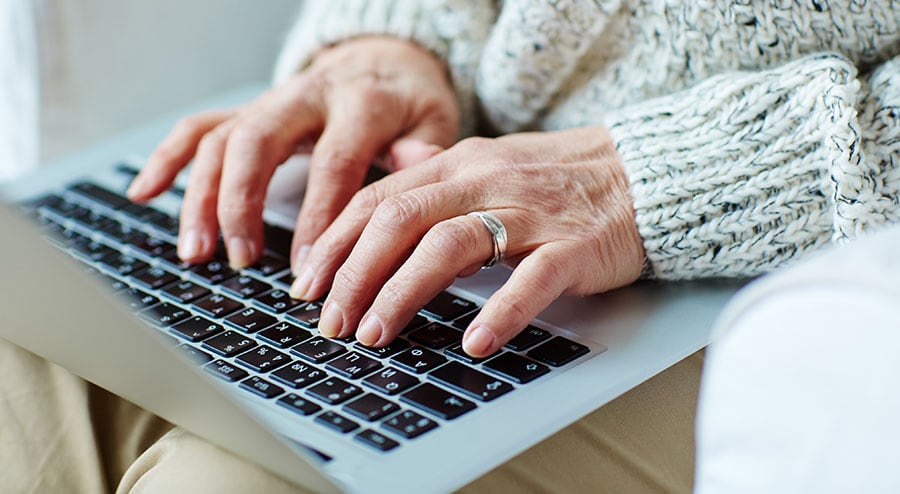If COVID-19 taught us anything, it’s that most meetings and appointments traditionally done in person can be done virtually. That includes emergency monitoring services, vital sign monitoring, and visits with healthcare providers. According to management consulting firm McKinsey & Company, telehealth usage for office visits and outpatient care surged to 78 times higher from the early days of the coronavirus pandemic to April 2020. Since then, use has stabilized but maintained an increase of about 38 times over pre-COVID-19 numbers.
One segment of the population that has greatly benefited from telehealth is seniors who, as a group, are more susceptible to severe COVID-19 infections. Telehealth enables more vulnerable people to get health consultations from the safety of their homes without having to go to a hospital or clinic, where they may become exposed to viruses or other pathogens.
According to a University of Michigan poll on healthy aging, older adults—despite being more tepid about modern technology—are beginning to warm up to the idea, with nearly half saying their telehealth appointment was better and more convenient than an in-person visit.
So, what does telehealth encompass, and how can you set up telehealth for the elderly loved ones in your life? The experts at Aging In Place took a closer look at this growing technology and how it can benefit seniors.

What Is Telehealth?
Telehealth is an all-encompassing term referring to digital information and communication technology—such as computers and mobile devices—that allows access to health care services remotely to manage an individual’s health care.
For less tech-savvy patients, some doctors may allow these calls to be done via a mobile phone or landline.

Some examples of Telehealth include:
- Remote consultations with your doctor or other healthcare providers
- Using a mobile phone, tablet, or other device to upload food logs, medications, blood sugar levels and other vital signs for review by your healthcare team
- Health education services, such as watching a video on cutting down on carbohydrates or downloading an app to help you keep track of your diet
- Using an online patient portal to see test results, schedule appointments, request prescription refills or email questions to your doctor
- Ordering testing supplies and medications online
- Getting preventative health care reminders via email to get your flu shot, a mammogram, or other preventative care
The term “telehealth” is often used interchangeably with telemedicine or telecare, but there are subtle differences between the three terms. Each term refers to a different way of administering health care via existing technologies or a separate area of medical technology.
Telehealth vs. Telemedicine vs. Telecare
Telehealth is the umbrella term that encompasses telecare and telemedicine.
Telemedicine is the provision of remote clinical services using telecommunications technology. This includes virtual visits with health care providers and the digital transmission of medical imaging, remote medical diagnoses and evaluations, and video consultations with specialists.
Telecare involves technology that enables elderly or disabled patients to stay independent and in their homes for as long as possible. This includes mobile monitoring devices, medical alert systems, and telecommunications technology like computers and telephones. Telecare technology enables medical staff or caregivers to monitor lifestyle changes over time and allows the care recipient to alert monitoring operators to real-time medical and non-medical emergencies.
How Does Telehealth Work?
There are several ways telehealth works:
- Using patient portals is a secure, faster, and more efficient way for patients to interact with doctors and their support staff. Patients log into the portal with a unique username and password. Once inside the portal, patients can send emails to their doctor or nurse, ask for prescription refills, and set up appointments. They can also review lab work or imaging test results.
- Some healthcare professionals allow telemed appointments in which you communicate with your doctor via real-time audio or video from a computer, mobile phone, or landline.
- Telecare includes monitoring vital signs–such as blood pressure, body weight, heart rate, and blood glucose levels–via sensors that transmit the data to the patient’s healthcare provider.
- Another popular Telecare option includes medical alert systems. Many of these devices have a call button that is worn by the care recipient that connects with a base. If the recipient experiences an emergency, such as a fall they cannot get up from, they simply press the button. The button signals a monitoring service that contacts an operator who speaks to the user via a two-way speaker in the base unit. If needed, the monitoring service can notify emergency responders or caregivers.
What Equipment Is Needed for Setting Up Telehealth?

Which telehealth equipment is needed depends on what type of services the care recipient requires. For example, telemedicine patient portals will likely require the user to have a computer or tablet with internet access or a smartphone. Telemed virtual appointments conducted via video also need a computer or tablet with internet service or a smartphone telehealth app to support whatever video conferencing platform the health care provider uses. For less tech-savvy patients, some doctors may allow these calls to be done via a mobile phone or landline.
Seniors eligible for telecare who are interested in monitoring services will want to go through a reputable medical alert system company. Services that offer 24/7 monitoring require a monthly fee and may provide all necessary equipment for free or a nominal one-time fee.
Patients who require monitoring of vital signs may be required to purchase special medical devices that work with their doctor’s monitoring service.
What Software Is Needed for Setting Up Telehealth?
This depends on the type of video conferencing your health care provider is using. For example, if you are using Zoom video conferencing, you will be instructed by the doctor’s office to download and install the software on your computer or download the mobile app to your phone. Your health care provider should provide instructions on how to do this. They can also help you troubleshoot any issues that arise or provide alternative methods, if necessary.
Telehealth, which encompasses telemedicine and telecare, has become a valuable tool for seniors. It enables them to have virtual office visits and health and emergency monitoring so they can live independently in their homes longer. Because of this, we believe telehealth is an amazing and useful resource.
What Are the Key Benefits of Telehealth?

Telehealth offers many benefits for patients and health care providers, including:
- Accessibility: Virtual office visits and remote monitoring can be a literal lifesaver for people who live in remote areas or do not have access to transportation.
- Time savings: Virtual telehealth appointments and access to online testing cut down on time spent driving to and from a doctor’s office. Online doctor visits also reduce the time spent in waiting rooms.
- Convenience: Telehealth allows patients to meet with their doctors, get prescription refills, or review lab work from the comfort of their homes.
- Peace of mind: Medical alert systems give care recipients and caregivers peace of mind that their loved one is protected in case of an emergency. They also help the elderly live independently longer.
- Cost savings: Telecare enables older adults to be more independent. While these services come at a cost, they pale in comparison to the cost of home health care or assisted living.
Common Issues with Setting Up Telehealth

Telehealth offers plenty of conveniences, but it is not flawless. Here are some issues that may present barriers to using telehealth:
- Lack of access to internet or appropriate devices: Many patients, especially the elderly or those who live in poverty, may not have access to the internet or a smartphone.
- Difficulty using technology: People with cognitive issues–or those who are simply not tech-savvy–may have trouble downloading or using video conferencing programs or patient portals.
- Certain health issues: Patients with hearing or vision loss may find it difficult to communicate via video conferencing or a two-way speaker on a medical alert system.
Bottom Line
Telehealth has been around since the 1960s, making its debut early in the space age for the purpose of monitoring the physiological parameters of astronauts. Technological advances have made telehealth more accessible in recent years, but we can contribute the current unprecedented surge in telehealth services to COVID-19.
Telehealth, which encompasses telemedicine and telecare, has become a valuable tool for seniors. It enables them to have virtual office visits and health and emergency monitoring so they can live independently in their homes longer. Because of this, we believe telehealth is an amazing and useful resource.
Telehealth relies on technology, but even if you or your loved one isn’t tech-savvy, it is possible to set up telehealth for the elderly so that both the care recipient and the caregiver benefit.
Why You Can Trust Our Review
You deserve the best products for a better quality of life. We strive to create honest, helpful reviews backed by firsthand shopping, testing, and research. Our content is medically reviewed and unbiased to help you choose the right medical alert system for you or your loved one.
From over 1,000 hours of research, we chose 11 of the top brands that we believe are the best medical alert systems. We did the following throughout our research process:
- Consulted with geriatricians and adult caregivers
- Mystery shopped the brands
- Surveyed medical alert system users
- Tested various medical alert systems
- Interviewed experts in the field
- Read hundreds of verified customer reviews from trusted third parties such as Better Business Bureau (BBB) and Trustpilot

